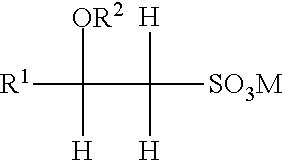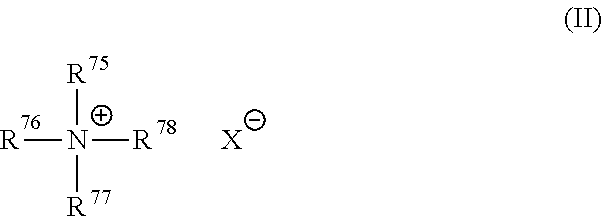Delivery particles
a technology of delivery particles and microcapsules, applied in the direction of detergent compounding agents, biocides, hair cosmetics, etc., can solve the problems of premature release of benefit agents, unattractive commercial processes, and effectively encapsulating a limited breadth, and achieves strong adhesion to anionic surfaces
- Summary
- Abstract
- Description
- Claims
- Application Information
AI Technical Summary
Benefits of technology
Problems solved by technology
Method used
Image
Examples
example 1
Preparation of Oil Phases and Pre-Reaction of Wall Material
[0386]A first oil phase, consisting of 50 g cedar oil, 0.65 g TBAEMA, and 0.52 g Beta-C, is mixed for about 1 hour before the addition of 26 g CN997. The solution is allowed to mix until needed later in the batch.
[0387]A second oil solution consisting of 200 g of cedar oil, 1.56 g Vazo-52 and 0.52 g Vazo-67 is added to a jacketed steel reactor. The reactor is held at 35° C., and the oil solution is mixed at 1000 rpm with a 2″ 4-tip flat blade mixer. A nitrogen blanket is applied to the reactor at a rate of 300 cc / min. The solution is heated to 75° C. in 45 minutes and held at 75° C. for 35 minutes, before cooling to 55° C. in 75 minutes. At 55° C., the first oil phase is added, and the combined oils are mixed for another 70 minutes at 55° C.
Water Phase Preparation
[0388]A water phase, containing 30 g of Colloid 351, 1.1 g 20% NaOH, 600 g water, and 1.56 g Vazo-68WSP, is prepared and mixed until the Vazo is dissolved. The wate...
example 26
Microcapsules in Leave-On-Conditioner
[0394]Selected microcapsules from the above examples are formulated into a leave-on-conditioner formulation as follows: to 98.0 grams of leave-on-conditioner (with a typical formulation given below) is added an appropriate amount of microcapsule slurry of examples 1 through 24, to deliver an encapsulated oil usage level of 0.5 wt %. The microcapsules are added on top of the conditioner formulation, then the contents are mixed using a SpeedMixer by Hauschild DAC 400FVZ, at 1000 RPM for 1 minute.
[0395]A typical composition of a leave-on conditioner formulation is given in the following table:
Ex. II (LOT)Components(%)PremixAminosilicone—PDMS1.0-1.5Gel matrix carrierBehenyl trimethyl ammonium chloride—Stearamidopropyldimethylamine0.60-0.8(SAPDMA), C18DTDMAC, C18 (Quaternium-18)0.45-0.6 Citric Acid (anhydrous)0.10-0.25Cetyl alcohol0.80-1.0 Stearyl alcohol0.54-1.0 Deionized WaterBalancePolymersHydroxyethylcellulose (HEC)0.15-0.50PEG-2M (Polyox WAR N-10...
example 27
Microcapsules in Shampoo
[0396]A subset of the capsules from the above examples is formulated into a rinse-off Shampoo formulation as follows: to 90.0 grams of shampoo formulation (with a typical formulation given below) is added an appropriate amount of microcapsule slurry of examples 1 through 24, to deliver an encapsulated oil usage level of 0.5 wt %. The microcapsules and water are added on top of the shampoo formulation, then the contents are mixed using a SpeedMixer by Hauschild DAC 400FVZ mixer, at 1850 RPM for 1 minute.
Typical composition of shampoo formulations are given in the examples below.
EXAMPLE COMPOSITIONIngredientIIIIIIWaterq.s.q.s.q.s.Polyquaternium 7612.50——Guar, Hydroxylpropyl—0.25—Trimonium Chloride2Polyquaterium 63——0.79Sodium Laureth Sulfate21.4321.4321.43(SLE3S)4Sodium Lauryl Sulfate (SLS)520.6920.6920.69Silicone60.751.000.5Cocoamidopropyl Betaine73.333.333.33Cocoamide MEA81.01.01.0Ethylene Glycol Distearate91.501.501.50Sodium Chloride100.250.250.25Fragrance0....
PUM
| Property | Measurement | Unit |
|---|---|---|
| fracture strength | aaaaa | aaaaa |
| size | aaaaa | aaaaa |
| size | aaaaa | aaaaa |
Abstract
Description
Claims
Application Information
 Login to View More
Login to View More - R&D
- Intellectual Property
- Life Sciences
- Materials
- Tech Scout
- Unparalleled Data Quality
- Higher Quality Content
- 60% Fewer Hallucinations
Browse by: Latest US Patents, China's latest patents, Technical Efficacy Thesaurus, Application Domain, Technology Topic, Popular Technical Reports.
© 2025 PatSnap. All rights reserved.Legal|Privacy policy|Modern Slavery Act Transparency Statement|Sitemap|About US| Contact US: help@patsnap.com



